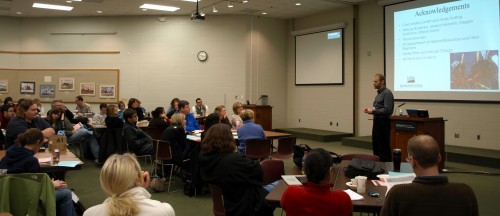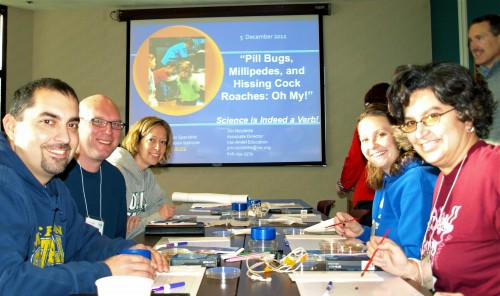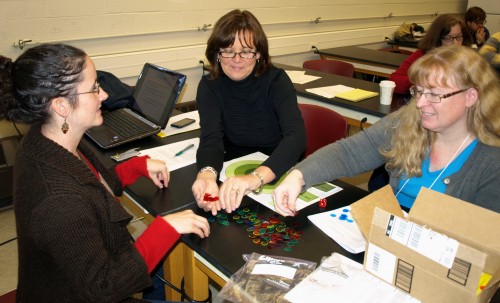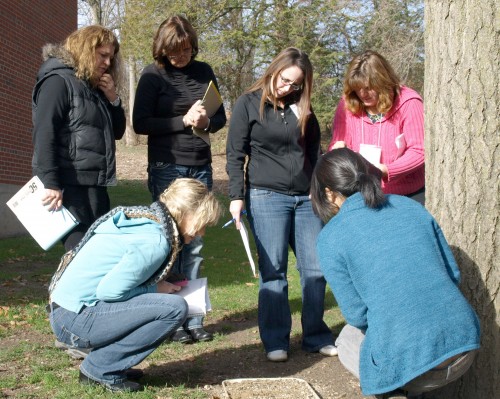Weeds, Seeds, and Dispersal! That was our theme for the December 5th KBS K-12 Partnership workshop. Our plenary speaker for the day was Dr. Joe Dauer, MSU research associate in Plant Biology. We learned that when he is not wearing his ‘weed ecologist’ hat, Dr. Dauer makes ‘the best pancakes’! We did not get any pancakes but we did get to hear his talk: ‘Going the Distance: Investigating dispersal across scales’.
 Dr. Dauer began with a discussion on investigative ecology. How and what do you investigate about weeds? One question would be – why do we see a patchy distribution of weeds and not an even distribution? Another could be – what is the role of humans in facilitating the movement of weeds or controlling it? During the talk we considered two methods of dispersal: wind and soil. When considering wind dispersal, the important questions according to Dr. Dauer are: How do the seeds move and how far do they move? For a plant relying on wind to disperse its seeds, it would be a smart move to get those seeds as high as it can. This is because the wind speeds are higher and the flow much more laminar at greater heights. Using some cool model airplanes for seed collection in one experiment, Dr. Dauer found that Horseweed seed dispersersed long-distances, travelling at least 6 meters above ground surface.
Dr. Dauer began with a discussion on investigative ecology. How and what do you investigate about weeds? One question would be – why do we see a patchy distribution of weeds and not an even distribution? Another could be – what is the role of humans in facilitating the movement of weeds or controlling it? During the talk we considered two methods of dispersal: wind and soil. When considering wind dispersal, the important questions according to Dr. Dauer are: How do the seeds move and how far do they move? For a plant relying on wind to disperse its seeds, it would be a smart move to get those seeds as high as it can. This is because the wind speeds are higher and the flow much more laminar at greater heights. Using some cool model airplanes for seed collection in one experiment, Dr. Dauer found that Horseweed seed dispersersed long-distances, travelling at least 6 meters above ground surface.
In the case of plants which disperse via the soil we learned that different plants have different ‘growing points’ i.e. the lowest point at which a plant must be cut in order to kill it. Dr. Dauer spoke of the ‘curious case of the Japanese Knotweed’. This is a plant that was introduced to the USA as a horticultural plant. The curious aspect is that since it does not produce viable seeds here what we see is basically the same plant all over eastern USA. Piece of friendly advice: do not try to grow, mow or use it for your garden deco. It is against the law in Michigan. The growing point of this weed is below the ground so mowing it does not kill it, all it does is spread it some more.
After the talk, session leaders got their 15 seconds of fame in which they had to do the best to sell their talk! Some of them did such a great job that I think they may have an alternative career in advertising!
 Teachers had multiple concurrent sessions to choose from throughout the day. Robby Cramer, of the Van Andel Education Institute, conducted a couple of sessions for elementary school teachers. Her session was marketed under the title ‘Pill Bugs, Millipedes, and Hissing Cockroaches OH MY!! Science is indeed a Verb!’ In this session, which was conducted in a room full of creepy crawlies, the teachers gained insights into making science fun by making their students think and act like scientists. They were given ‘QPOE2’ (Question, Prediction, Observation, Explanation, Evaluation), Investigative Organizer Step Books, and Sticker Books to help them conduct investigations in their classrooms.
Teachers had multiple concurrent sessions to choose from throughout the day. Robby Cramer, of the Van Andel Education Institute, conducted a couple of sessions for elementary school teachers. Her session was marketed under the title ‘Pill Bugs, Millipedes, and Hissing Cockroaches OH MY!! Science is indeed a Verb!’ In this session, which was conducted in a room full of creepy crawlies, the teachers gained insights into making science fun by making their students think and act like scientists. They were given ‘QPOE2’ (Question, Prediction, Observation, Explanation, Evaluation), Investigative Organizer Step Books, and Sticker Books to help them conduct investigations in their classrooms.
Jenny Dauer (the one who gets to eat Dr. Joe Dauer’s best pancakes) and Andy Anderson conducted an MSP Carbon Session for MS/HS teachers. Their strategy to attract teachers to ‘Ecosystems: Carbon Cycles and Energy Flows!’ was having ‘cool PowerPoint tricks’. They delivered on their promise and the teachers had a great time exploring carbon-transforming processes at an ecosystem scale. In good GK-12 tradition, they also had an online interactive activity called Sunny Meadows in which students have to adopt the best strategy that leads to the maximum number of foxes (representing the top trophic level) at the end of 10 (virtual) years.
 To explore the Weeds, Seeds, and Dispersal topic, the GK-12 fellows come up with innovative, interactive and interesting concurrent session ideas. When it comes to designing games, we have a reigning king at KBS. Michael can sell any of his sessions by just hinting at an exciting game. And that is exactly what happened. Michael Kuczynski, Anne Royer and Sara Garnett teamed together to conduct ‘Seeds on the Run: A Model of Seed Dispersal’. They designed a game to explore the Janzen–Connell hypothesis. This widely accepted hypothesis explains the distribution of tree species in tropical rainforests. The game used tiddlywinks (they claimed it was deceptively simple) to walk students through predicting, collecting data and graphing it to understand the hypothesis.
To explore the Weeds, Seeds, and Dispersal topic, the GK-12 fellows come up with innovative, interactive and interesting concurrent session ideas. When it comes to designing games, we have a reigning king at KBS. Michael can sell any of his sessions by just hinting at an exciting game. And that is exactly what happened. Michael Kuczynski, Anne Royer and Sara Garnett teamed together to conduct ‘Seeds on the Run: A Model of Seed Dispersal’. They designed a game to explore the Janzen–Connell hypothesis. This widely accepted hypothesis explains the distribution of tree species in tropical rainforests. The game used tiddlywinks (they claimed it was deceptively simple) to walk students through predicting, collecting data and graphing it to understand the hypothesis.
Despite having planted a known mixture of seed in the BEST plots, teachers and students have found that there are tons of other ‘volunteers’ growing there. Fellows Cara Krieg, Tyler Bassett and Dustin Kincaid pitched their session towards offering an answer to this question. In the session titled ‘Weeds: Tricks of the trade’ they explored how plant traits and land-use history influence the assembly of plant communities. As said in their sales pitch, they focussed on the volunteer species commonly found in the BEST plots. They also conducted an activity to predict which traits make certain weeds more successful than others.
 Fellows Tomomi Suwa, Liz Schultheis and Jakob Nalley promoted their session called ‘The double life of a squirrel – seed disperser and predator’ by referring to an intriguing ‘Chocolate Chip Cookie Study’. Teachers learnt that the 1985 study researched the fine dining habits of squirrels. This study was replicated in the session using trays of sunflower seeds. While conducting the activity, there was an exciting discovery: an actual cache of seeds in a tree hollow! The teachers also explored the different strategies employed by plants to spread their seeds.
Fellows Tomomi Suwa, Liz Schultheis and Jakob Nalley promoted their session called ‘The double life of a squirrel – seed disperser and predator’ by referring to an intriguing ‘Chocolate Chip Cookie Study’. Teachers learnt that the 1985 study researched the fine dining habits of squirrels. This study was replicated in the session using trays of sunflower seeds. While conducting the activity, there was an exciting discovery: an actual cache of seeds in a tree hollow! The teachers also explored the different strategies employed by plants to spread their seeds.
For the final session ‘Ecology and Evolution in the Human Microbiome’ Jennifer Doherty posed some interesting questions, one of which was ‘What is a faecal transplant and why would someone do that?’. Her strategy seemed to work and the session was standing room only! She applied the concepts of community ecology and evolution to investigate Human Microbiome scenarios. A couple of these scenarios for the curious: Bacterial cells in your body outnumber your body cells 10:1 and the back of your heel and the area between your toes have different bacterial communities!
After the concurrent sessions, teachers Lisa W. and Marty B. gave us an update on their Alaskan Trip. They had gone to the Alaskan LTER in July 2012. From what we heard they had tons of fun, learned a few things, got stranded in a no-horse town and yet managed to get a few cast-off antlers shipped back home!
Thanks to all of you for another wonderful workshop!
Written by K-12 Partnership member Joelyn de Lima.
